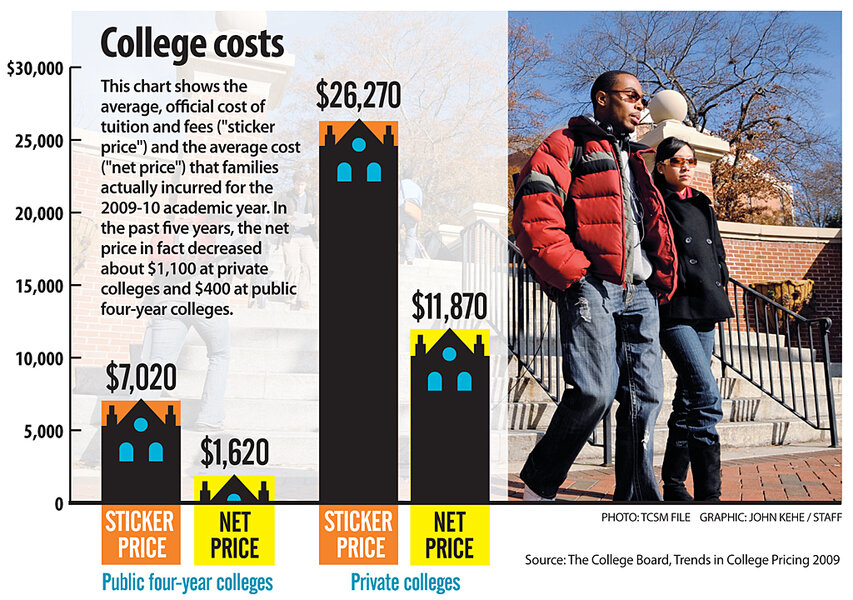College tuition: New law aims for more transparency in costs
Loading...
Can I afford it? That's a big question for students and parents as they contemplate college.
The sticker price – the published rate for tuition and fees – prompts many families to rule out certain colleges or skip college altogether. Others underestimate costs and get into serious debt. For years, many have complained that it's nearly impossible to get a solid cost figure from a school until the bill arrives.
But now it's getting easier to obtain a ballpark "net price" – what students must pay once they receive financial aid.
This past summer, a federal law kicked in requiring colleges not only to be more transparent about their tuition and room and board costs, but also to give reasonable estimates for fees, books, and personal expenses. Students can find such information for any school on the US Department of Education's College Navigator website. Here they can also find basic statistics about each school's financial aid.
Already, some colleges offer net-price calculators (NPCs) on their websites – which the law requires by October 2011. In about 15 minutes, prospective students can plug in a range of financial and academic information and get a customized estimate of what they would have to pay.
A low-income student may discover that she'd be expected to pay only $5,000 a year for a school with a $40,000 sticker price. "That can be a huge wake-up call to families that thought their dream schools would be out of reach," says Sally Rubenstone, a senior adviser at the college planning service company College Confidential.
The University of Arkansas in Fayetteville has had its calculator online most of this year, and it's already getting several hundred hits a month, says financial aid director Kattie Wing. "We haven't had any complaints," she says. "I thought we'd have people saying, 'The calculator said one thing, but I got something else [in my financial aid package],' but it's been very smooth."
By taking into account special circumstances such as veterans' benefits and offering instructions in both Spanish and English, the University of Arkansas calculator is particularly sophisticated, say officials at Student Aid Services, which counts the school among about 155 clients that so far plan to use its customized calculator service.
Schools such as Purdue University and the Massachusetts Institute of Technology have built their own calculators. Others may opt to use a federally built template. And the College Board, a higher-education membership association based in New York, is piloting a calculator system that officials say will make it easier for students to do comparisons between schools.
One hope is that families won't wait until a student's senior year in high school to explore college costs. "It would be great if these calculators were used by kids in eighth or ninth grade, who can see that their academic aspirations might lead to admission to a school that's generous with financial aid," says Myra Smith, the College Board's executive director of financial aid services.
For ballpark figures, the calculators are helpful, Ms. Rubenstone says, but many families have unique circumstances that the calculators can't take into account. And one key element is difficult to predict: merit aid. "Only a handful of colleges get very specific about who gets their merit scholarships," she says, and that can make a big difference in a student's bottom line.
Student advocates are watching closely to see if the NPCs fulfill the spirit of the law. "Some calculators take into account loans [and work-study earnings] and get down to zero" for the price they highlight to students, which could be misleading, says Matthew Reed, program director of the Institute for College Access & Success in Oakland, Calif. Students should be able to easily compare colleges based on the total of what they would have to pay, he says, even if they might put off some of the expense through loans.
Another provision of the new federal law: Schools now have to post the list of required textbooks with the course schedule used for registration, so that students can plan for those costs and shop around for the best deals.
For all the helpfulness of online tools, sometimes personal mentoring works best. In an effort to boost college attendance and success among low-income and first-generation students, the Illinois Student Assistance Commission started ISACorps last year – a network of more than 70 recent graduates who are paid $25,000 a year to assist younger students in their communities.
ISACorps worker Kelly Morgan helps students in the Chicago suburbs look beyond sticker prices, research schools' financial aid policies, and fill out an online form (the FAFSA4caster) to estimate their federal aid.
When students get accepted and look at their aid letters, "we dissect that information," Ms. Morgan says. Some scholarships may cover books and other expenses, while other schools may claim that books will cost only $100 a semester, a suspiciously low figure.
Morgan knows how confusing it can be to determine which college options are affordable. Her parents had a strong aversion to the high sticker price of private Augustana College in Rock Island, Ill., but she says she received so much financial aid there that it turned out to be cheaper than her sister's education at a public university.






